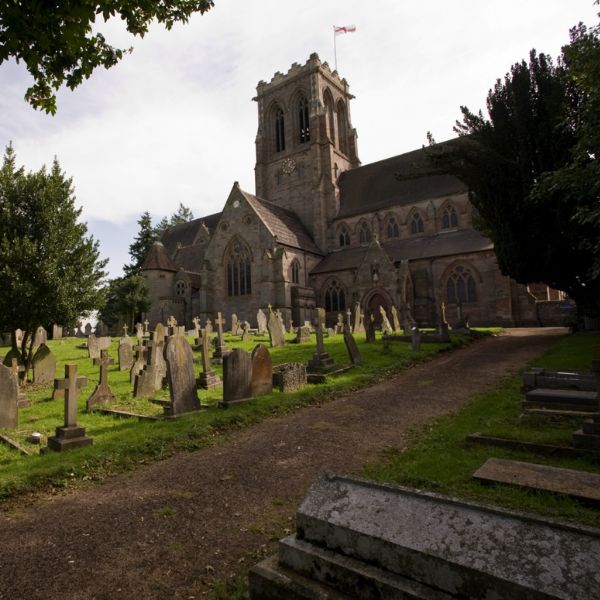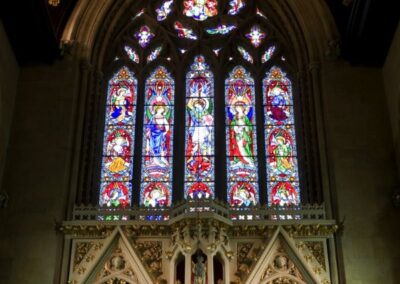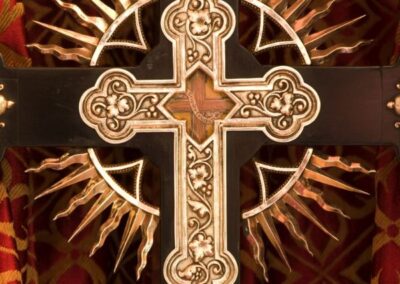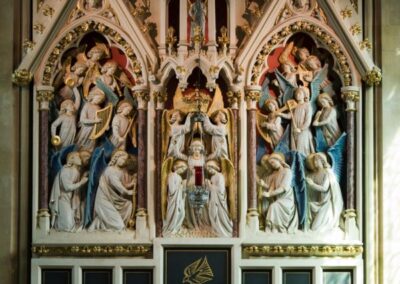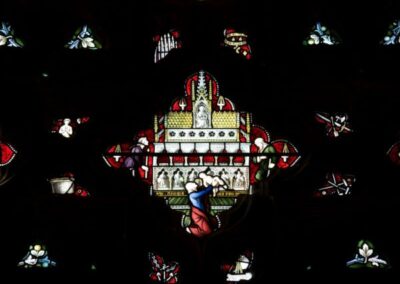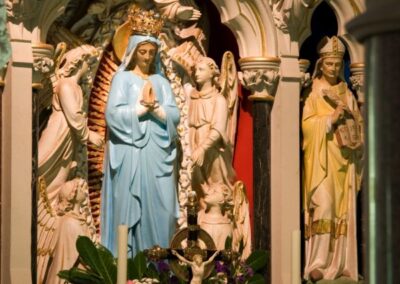Belmont Abbey was founded in 1859, and until 1917 served as the common novitiate and house of studies for the English Benedictine Congregation. At the same time Bishop Brown of Newport and Menevia was given the church as his cathedral, and so had a monastic chapter. This arrangement as a cathedral priory lasted until 1920. In 1917 General Chapter declared Belmont an independent house and it was raised to the rank of Abbey by the bull Præclara Gesta in 1920.
The monastic community now undertakes numerous works including the pastoral care of the Catholics in Herefordshire, while other monks work in parishes in West Cumbria and South Wales. In addition the community maintains a small foundation near Lima in Peru – the Monastery of the Incarnation.
Hedley Lodge is the Abbey guesthouse where groups and individuals are welcomed for retreats, conferences and holiday breaks. The community has been involved in educational work for over seventy years: this continues with visiting school groups and local catechetical work.
The Church at Belmont was built to the designs of Edward Welby Pugin, son of the great Augustus Welby Pugin. Built in the decorated, early English style, it demonstrated the resurgent optimism of the restored Catholic faith. The exterior is in local pink sandstone, simple and unadorned, especially the west front, which is reminiscent of many classical monastic facades of the fourteenth century. The interior is faced with warm Bath stone. Light from the rich aisle windows frequently suffuses the whole space. It is a beautiful place to sit on a sunny summer’s afternoon.
The Church is dominated by four elegant, steeply pointed, arches, which support the central tower, leading the eye heavenwards. Originally this was the crossing, but now the altar stands here at the centre of the Church, well suited to the revised liturgy.
On the modern stone altar is carved the figure of the Lamb of God. Symbols of the four evangelists, (Matthew the man, Mark the lion, Luke the (Hereford!) bull, and John the eagle) stand around on the corbels of the central pillars, calling to mind the heavenly liturgy of the Book of Revelation and the worship of the Lamb.
Belmont Abbey High AlterOriginally the high altar stood under the angel reredos at the East End, in a spacious sanctuary. This is now the Blessed Sacrament Chapel, and the place where guests often join us for our celebration of the Divine Office. Below the window showing the angels Michael, Raphael and Gabriel and the nine choirs of angels, the reredos continues this theme with an angelic orchestra sounding of praises of God. This was decorated in 1978 with colour washes and gold leaf.
Under a magnificent wooden roof stands the monastic choir, where the Community gathers five times a day for the Divine Office and Mass.
Moving around the Church we pass side altars, dedicated to The Blessed Virgin, St Joseph, St Benedict, and a Memorial Altar commemorating the old boys of the school who lost their lives in the Second World War. The North Transept was formerly an elaborate chantry chapel dedicated to the Welsh Saints.
Visitors to the Abbey Church are soon aware that they are in the presence of Angels. The Church is dedicated to St Michael and All Angels, as was often the case of hilltop churches.
The finest stone angels are perhaps those in the nave. The whole Church was expensive for its time – costing £45,000, much of the money being used in the design and construction of the carvings which did not just come out of a Victorian architect’s pattern book. But angels are everywhere – someone once counted 156! With harps, cymbals and pipes the heavenly orchestra accompanies monks and worshippers singing the praises of God.
Perhaps the finest stained glass is in the window at the East End. In its five lights we see Belmont’s patron Michael with his shield and sword in hand, trampling afoot the dragon. To the right is gentle Gabriel who brought the good news of the Incarnation, and to the left is Raphael, who figures in the Book of Tobit and is the angel associated with healing.
Around them are angels representing the nine choirs of angels, and in the rose window above more angels form a swirling stream around the central figure of Christ.St Benedict himself encouraged his monks to be aware of the Divine Presence everywhere, and of his angels watching over us especially as we pray:
“Let us be mindful of the Prophet’s words… chant the psalms with understanding! and yet again: In the presence of the angels I will bless you. (Psalm 137). We should consider, then, with what reverence we ought to stand in the sight of God and of his angels, and chant Rule of St Benedict Ch.19 the psalms in such a way that our minds are in harmony with our voices”.
The tiny chapel of St Benedict, (opened in 1862 on the feast of All Benedictine Saints and completed in 1875) was originally set apart for the private prayer of the Novices. It is a colourful gem whose reredos portrays scenes from the life of St Benedict and whose windows show this great tradition of monasticism gave many saints to the Church.
At the centre of the reredos stands St Benedict, holding his Rule, and calling his monks to listen. To the left is a panel showing his early life in the cave at Subiaco.
The windows offer a short history of monasticism in the west through the saints that they portray. St Scholastica, Benedict’s sister, is surrounded by the monks and Pope St Gregory the Great, who wrote the Life of Benedict. He of course sent his monk St Augustine to England, and he too is portrayed. There follow many great figures of English Monasticism, such as St Benet Biscop monastic founder, St Bede the writer and historian, and St Boniface the missionary and martyr.
St Anslem philosopher and theologian is portrayed, as is St Wulstan, the last Anglo-Saxon Bishop, laying his crozier upon the tomb of St Edward the Confessor from whom he received his see.
To the right Benedict is shown at the moment of his death, receiving the Body and Blood of the Lord. Together they show the man who began his monastic journey alone as a solitary hermit, but ended up as a thoroughly social monk, who dies amongst his brethren who support his weak limbs and help him offer the prayer that he could no longer make alone.
Location
Ruckhall Ln
Hereford
HR2 9RZ
- Cafe on site
- Open each day from 6am to 9pm.
- Abbey Shop open Monday – Saturday 2pm – 4pm

